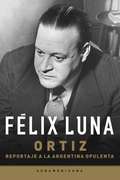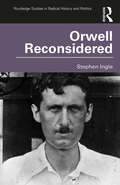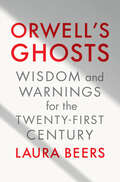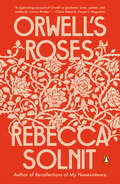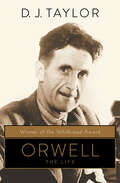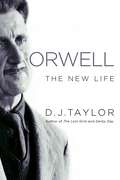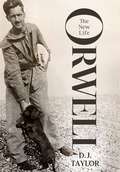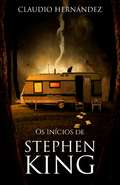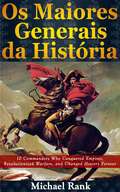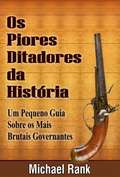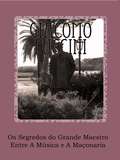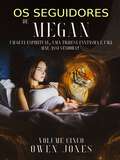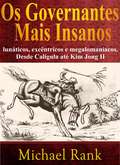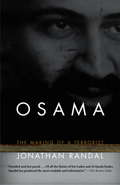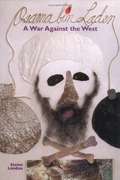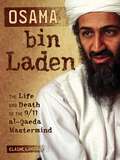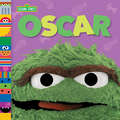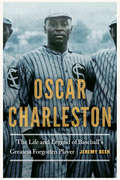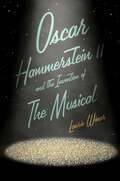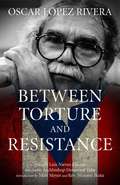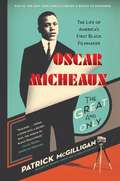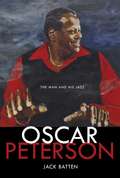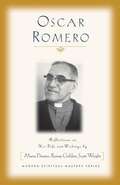- Table View
- List View
Ortiz: Reportaje a la Argentina opulenta
by Felix LunaFélix Luna reconstruye la trayectoria íntima y política del presidenteRoberto M. Ortiz, y el drama personal que afrontó cuando se hallabaempeñado en purificar el sistema electoral. El autor de «El 45» utiliza una original técnica expositiva paraaproximarse a la opulenta Argentina de los alrededores de 1940, quevivía una época de transformaciones sociales y económicas, como un oasispacífico en medio de la catástrofe de la Segunda Guerra Mundial. Estaobra constituye además un homenaje a la política del consenso encaradapor Ortiz para recuperar la dignidad de los comicios viciados por elfraude. La contraposición de la documentada crónica política con algunastípicas expresiones de la época -desde las modas hasta las crónicaspoliciales- permite al lector recuperar la atmósfera del país que siguióla lucha y el drama del presidente ciego.
Orwell Reconsidered (Routledge Studies in Radical History and Politics)
by Stephen IngleGeorge Orwell has had a profound influence on modern politics and culture. He is regularly invoked as an authority by journalists, commentators and politicians, and his works speak with increasing relevance to our polarised and media-saturated society. Stephen Ingle explores Orwell’s character, his life and his beliefs by guiding the reader through the main events, private and public, that shaped his life and major works. This includes his time fighting in the Spanish Civil War as well as the writing of classics like Animal Farm and 1984. The book also reconsiders Orwell’s legacy and contextualises his contemporary resonance. Orwell, it is argued, is more concerned with morality than ideology. This book will be of significant interest to students and other readers interested in Orwell’s life as well as his profound contribution to the history of social and political thought and English literature.
Orwell's Ghosts: Wisdom and Warnings for the Twenty-First Century
by Laura BeersFor the 75th anniversary of 1984, Laura Beers explores George Orwell’s still-radical ideas and why they are critical today. George Orwell dedicated his career to exposing social injustice and political duplicity, urging his readers to face hard truths about Western society and politics. Now, the uncanny parallels between the interwar era and our own—rising inequality, censorship, and challenges to traditional social hierarchies—make his writing even more of the moment. Invocations of Orwell and his classic dystopian novel 1984 have reached new heights, with both sides of the political spectrum embracing the rhetoric of Orwellianism. In Orwell’s Ghosts, historian Laura Beers considers Orwell’s full body of work—his six novels, three nonfiction works, and brilliant essays on politics, language, and the class system—to examine what “Orwellian” truly means and reveal the misconstrued thinker in all his complexity. She explores how Orwell’s writing on free speech addresses the proliferation of “fake news” and the emergence of cancel culture, highlights his vivid critiques of capitalism and the oppressive nature of the British Empire, and, in contrast, analyzes his failure to understand feminism. Timely, wide-ranging, and thought-provoking, Orwell’s Ghosts investigates how the writings of a lionized champion of truth and freedom can help us face the crises of modernity.
Orwell's Roses
by Rebecca Solnit&“An exhilarating romp through Orwell&’s life and times and also through the life and times of roses.&” —Margaret Atwood &“A captivating account of Orwell as gardener, lover, parent, and endlessly curious thinker.&” —Claire Messud, Harper's&“Nobody who reads it will ever think of Nineteen Eighty-Four in quite the same way.&”—Vogue A lush exploration of roses, pleasure, and politics, and a fresh take on George Orwell as an avid gardener whose political writing was grounded in his passion for the natural world&“In the year 1936 a writer planted roses.&” So begins Rebecca Solnit&’s new book, a reflection on George Orwell&’s passionate gardening and the way that his involvement with plants, particularly flowers, and the natural world illuminates his other commitments as a writer and antifascist, and the intertwined politics of nature and power. Sparked by her unexpected encounter with the surviving roses he planted in 1936, Solnit&’s account of this understudied aspect of Orwell&’s life explores his writing and his actions—from going deep into the coal mines of England, fighting in the Spanish Civil War, critiquing Stalin when much of the international left still supported him (and then critiquing that left), to his analysis of the relationship between lies and authoritarianism. Through Solnit&’s celebrated ability to draw unexpected connections, readers encounter the photographer Tina Modotti&’s roses and her Stalinism, Stalin&’s obsession with forcing lemons to grow in impossibly cold conditions, Orwell&’s slave-owning ancestors in Jamaica, Jamaica Kincaid&’s critique of colonialism and imperialism in the flower garden, and the brutal rose industry in Colombia that supplies the American market. The book draws to a close with a rereading of Nineteen Eighty-Four that completes her portrait of a more hopeful Orwell, as well as a reflection on pleasure, beauty, and joy as acts of resistance.
Orwell: The Life (Books About Bks.)
by D. J. TaylorWinner of the Whitbread Biography Award: the authoritative biography of one of the greatest authors of the twentieth century It was not easy to bury George Orwell. After a lifetime of iconoclasm, during which he professed no interest in religion and no affiliation with any church, he asked to be buried in an Anglican churchyard--but none would have him. Orwell's friends fought for him to have a proper grave, however, and the author of 1984, Animal Farm, and Homage to Catalonia, among other brilliant works of prose, poetry, and journalism, was laid to rest in a quiet country cemetery. Almost immediately, his legacy was in dispute. Orwell did not want any biographies written of him, but that has not stopped scholars from trying. Of all those published since the author's death in 1950, D. J. Taylor's prize-winning book is considered the most definitive. Born in India, Orwell spent his forty-six years of life traveling the British Empire and confronting the world head on. From the trenches of Spain to the top of bestseller lists, Taylor presents Orwell fully--as a writer, social critic, and human being.
Orwell: The New Life
by D. J. TaylorA fascinating exploration of George Orwell—and his body of work—by an award-winning Orwellian biographer and scholar, presenting the author anew to twenty-first-century readers. We find ourselves in an era when the moment is ripe for a reevaluation of the life and the works of one of the twentieth century&’s greatest authors. This is the first twenty-first-century biography on George Orwell, with special recognition to D. J. Taylor's stature as an award-winning biographer and Orwellian. Using new sources that are now available for the first time, we are tantalizingly at the end of the lifespan of Orwell's last few contemporaries, whose final reflections are caught in this book. The way we look at a writer and his canon has changed even over the course of the last two decades; there is a post-millennial prism through which we must now look for such a biography to be fresh and relevant. This is what Orwell: The New Life achieves.
Orwell: The New Life
by D.J. TaylorOver seventy years since his premature death, George Orwell (1903-50) has become one of the most significant figures in western literature. His two dystopian masterpieces, Animal Farm (1945) and Nineteen Eighty-Four (1949) have together sold over 40 million copies. Even now, he continues to exert a decisive influence on our understanding of international power-politics. D.J. Taylor's new biography, the first full-length study for 20 years, draws on a wide range of previously unseen material - newly-discovered letters to old girlfriends and professional colleagues, the recollections of the dwindling band of people who remember him, new information about his life in the early 1930s - to produce a definitive portrait of this complex, driven and self-mythologising man.
Os Inícios de Stephen King: Esta é a mais completa biografia sobre Stephen King
by Claudio HernándezO escritor de Maine, como muitos o chamam, estava predestinado a ser o melhor escritor de terror da história. Assim o demonstra em sua carreira literária. Apesar de ter que suportar centenas de recusas de seus primeiros contos e livro, o destino estava escrito: a prego que suportava as cartas de rejeição cairam finalmente no chão. Stephen King começou a escrever bem jovem aos oito anos de idade, e publicaria no início seus primeiros contos. Liam os meninos da sua escola. Não foi nada fácil chegar até a publicação de "Carrie", livro com o qual inicia seu lançamento profissional. Anteriormente substituia com muitos e variados trabalhos, e os cheques que cobrava por seus contos. A morte e o medo sempre estiveram a seu lado desde que cavava fossas no cemitério local na sua adolescência, com seu primeiro trabalho pago. Sua tenacidade e constância o fizeram ser reconhecido como o "Rei", tributo a seu sobrenome "King" que o caía bem. Aqui descobrirás seu início: desde sus tataravôs, avós, seus pais, a pobreza, a caixa de manuscritos de seu pai, seus primeiros contos, a época que não quer lembrar do instituto, a universidade, seus primeiros livros, seu trabalho como professor de língua inglesa, seu alter ego, seus problemas... e finalmente seu sucesso entra as massas. Este é um estudo de sua primeira etapa, a mais pura de Stephen King, a que nos marcou e a todos por assim o chamarmos de o rei do terror. Um dia seu dedo caiu ao azar sobre um mapa dos Estados Unidos, no Colorado sobre o Hotel Stanley. e prosseguiu o destino que tinha marcado para seguir. Advinhe qual história é essa?
Os Maiores Generais da História
by Michael Rank Pedro ReisO autor do bestseller número 1 "The Crusades and the Soldiers of the Cross" chega com um incrível livro sobre a mentalidade dos maiores generais da história. Seja Aníbal de Cartago marchando com seus elefantes pelos Alpes e atacando o coração de Roma, Khalid ibn al-Walid com sua carreira militar invicta e destruição do Império Persa enquanto dominava os bizantinos, ou o general russo Alexander Suvorov e seu uso da baioneta capaz de vencer qualquer exército europeu, os grandes líderes militares exerceram uma grande influência na sociedade. Este livro trará uma visão sobre as vidas e a forma de combate usada pelos dez maiores comandantes militares da história. Alguns conquistaram a total expansão do mundo até então conhecido, como fez Alexandre, o Grande. Outros eram hábeis estadistas capazes de transformar vitórias militares em ganhos políticos de longo alcance, como Júlio César, cuja vitória sobre os gauleses e sobre seus inimigos políticos permitiu séculos da hegemonia do Império Romano. Também serão mostradas as táticas que foram utilizadas para que fosse possível a vitória sobre exércitos maiores; seja Napoleão, que quase conquistou a Europa com sua habilidade de inesperadamente marchar para longe da força principal do inimigo e se concentrar num ponto fraco porém vital; ou o movimento de pinça executado por Aníbal, invejado por outros estrategistas militares por 2.000 anos. Independente do contexto em que viviam, estes líderes mostram como que o comandante certo, no momento histórico certo, é capaz de destruir um império, mudar a civilização e alterar o curso da história para sempre.
Os Piores Ditadores Da História: Um Pequeno Guia Sobre Os Mais Brutais Governantes
by Michael Rank Makoto YamamotoSórdidos, brutais e breves.Essa é a maneira como o filósofo inglês Thomas Hobbes descreveu o estado natural da humanidade e do estado em que os seres humanos inexoravelmente ficariam sem uma autoridade forte e central. No entanto, Hobbes provavelmente concordaria que viver sob a tutela de um mau governante também pode levar à morte violenta. Afinal, ele viveu apenas um século após o sangrento reinado de Henrique VIII; cento e cinquenta anos após os conquistadores espanhóis testemunharem Montezuma II oferecer milhares de sacrifícios humanos; e pouco mais de quatro séculos depois que Genghis Khan cavalgou toda a Eurásia, deixando para trás morte e destruição suficiente para despovoar grandes partes do globo.Este novo e emocionante livro do historiador Michael Rank analisa a vida e a época dos piores ditadores da história. Você aprenderá sobre os reinados e as ações mais violentas deles, como... - O imperador Nero e os assassinatos dos membros de sua família, a suspeita pelo incêndio de Roma e a execução generalizada de minorias religiosas, o que fez muitos dos primeiros cristãos acreditarem que ele era o anticristo. - Herodes, o Grande, e seu gosto pelo massacre, os assassinatos de familiares e até mesmo infanticídios para manter seu governo. - As conquistas militares de Genghis Khan, que matou dezenas de milhões de pessoas e afugentou mais outros milhões; por sua causa, florestas voltaram a crescer em campos agrícolas abandonados, e os níveis de carbono na atmosfera caíram, resultando no primeiro caso de resfriamento global causado pelo homem. - Vlad, o Empalador (também conhecido como Vlad Dracul, homônimo do vampiro) e seu hábito de empalar que afligiu mais de 20 mil vítimas, fazendo até mesmo um exército mais forte recuar ao testemunhar tal carnificina. Esses quatro líderes, além de outros seis ditadores da história antiga, medieval e moderna, são apresentados neste livro. Saiba mais
Os Segredos do Grande Maestro: Entre A Música e A Maçonaria
by Paolo NutiGiacomo Puccini e a maçonaria: que ligação há entre um dos maiores compositores italianos de todos os tempos e essa controversa associação? Em uma erudita mescla entre romance e autobriografia, o autor junta anedotas pessoais a registros históricos, levantando dúvidas, colocando interrogações, e acompanhando o leitor em uma fascinante viagem para descobrir os segredos do Grande Maestro.
Os Seguidores de Megan: Um guia espiritual, uma tigresa fantasma e uma mãe assustadora! (A série Megan #5)
by Owen JonesUm guia espiritual, uma tigresa fantasma e uma mãe assustadora! Megan recebe permissão para realizar uma das suas ambições: entrar no Facebook e no Twitter! Megan é uma garota de treze anos com poderes sorenaturais. Alguns ainda estão apenas parcialmente desenvolvidos e outros já são mais fortes, mas ela ainda não sabe como usá-los. Seu maior problema nesse momento é encontrar um Professor capaz de lhe mostrar como lidar com eles apropriadamente. Outra dificuldade é o fato de não conhecer ninguém que saiba algo sobre poderes sobrenaturais. Na verdade, sua mãe é violentamente contra qualquer coisa que seja sobrenatural, assim como sua mãe antes dela. As únicas pessoas que parecem estar dispostas a ajudá-la estão mortas; não que isso faça alguma diferença para Megan. Ela aceita essa ajuda de braços abertos. Os Seguidores de Megan se refere aos seus seguidores na Internet. Como acabou de completar treze anos, seus pais e os grandes sites agora permitem que ela os use, então Megan faz contas no Twitter, Facebook e LinkedIn. Wacinhinsha lhe dá uma lição sobre comunicação e como percebê-la em um nível espiritual.
Os governantes mais insanos: lunáticos, excêntricos e megalomaníacos. Desde Calígula até Kim Jong II
by Michael Rank Rodrigo AndreaPoucos misturas são tão tóxicas quanto o poder absoluto e insanidade. Quando não há obstáculos para os caprichos delirantes de um líder serem postos em prática, todos os tipos de resultados bizarros são possíveis. Seja o sultão otomano Ibrahim I praticando arco e flecha nos servos do palácio ou enviando seus conselheiros para encontrar a mulher mais gorda do império para ser sua esposa, ou então o presidente do Turcomenistão Turkmenbashi dando seu próprio nome aos dias da semana, e construindo uma estátua dourada de 24 metros voltada para o sol. Os líderes insanos têm atormentado a sociedade por milênios Esse livro irá analisar as vidas das dez diguras mais desequilibradas da história. Alguns sofriam com desordens genéticas que levaram à esquizofrenia, como por exemplo o rei francês Charles VI, que pensou que era feito de vidro. Outros acreditavam ser eles mesmos os representantes de Deus na terra e escreveram escritos religiosos que garantiam que o leitor iria para o céu, mesmo que o mesmo fosse pouco alfabetizado. Qualquer que fosse o seu background, esses ditadores mostram que a dinastia política se certificava que um herdeiro leg'timo sempre chegasse ao trono - não obstante sua condição mental - e que o poder pode destruir uma menta pior do que qualquer doença mental.
Os últimos dias de Estaline
by Joshua RubensteinJoshua Rubenstein lança uma nova luz sobre a acção de Beria, Malenkov, Khrushchev, e outros "camaradas de armas", que bem entenderam o significado da morte iminente do ditador; relata os eventos documentados de testemunhas da sua morte, em comparação com as versões oficiais; os rumores sobre os planos de Estaline para forçar o exílio de judeus soviéticos; as respostas de Eisenhower e o secretário de Estado Dulles aos gestos conciliatórios do Kremlin após a morte de Estaline; e as repercussões da quebra do regime de terror de Estaline. Um relato impressionante dos meses antes e depoisda morte de Estaline e de como o seu desaparecimento modificaria o curso da História do século xx.Joshua Rubenstein leva-nos de volta à segunda metadede 1952, quando ninguém poderia prever um fim ao regime assassino de Estaline. Estava prestes a desafiar o recém-eleito presidente dos Estados Unidos, Dwight Eisenhower, com as forças armadas, enquanto ampliava uma campanha odiosa contra os judeus soviéticos. O colapso repentino de Estaline, que o leva à morte, em Março de 1953, foi tão dramático e misterioso como a sua vida. Não é exagero dizer que a sua morte marcou um ponto de viragem importante no século xx. Os Últimos Dias de Estaline é um envolvente relato dos últimos meses de vida activa do ditador, da vigília no seu leito de morte e da sucessão de acontecimentos internacionais que se seguiram ao seu desaparecimento. Joshua Rubenstein lança uma nova luz sobre a acção de Beria, Malenkov, Khrushchev e outros «camaradas de armas», que bem entenderam o significado da morte iminente do ditador. Relata os eventos documentados por testemunhas da sua morte em comparação com as versões oficiais, os rumores sobre os planos de Estaline para forçar o exílio de judeus soviéticos, as respostas de Eisenhower e do secretário de Estado Dulles aos gestos conciliatórios do Kremlin após a morte de Estaline e as repercussões da quebra do regime de terror do ditador. «Joshua Rubenstein, num relato vívido e vivo, descreve os derradeiros meses de vida de Estaline e o contexto do seu leito de morte, dando conta do verdadeiro significado desse ponto de viragem.» Robbie Millen, The Times «O relato de Joshua Rubenstein sobre a morte de Estaline e as suas consequências imediatas está muito bem feito [...] um livro acessível e fascinante.» Geoffrey Roberts, Irish Times «Intrigante.» David Mikics, Tablet «Um trabalho fascinante.» Amy Lewonstin, Library Journal «O relato extremamente interessante de Joshua Rubenstein sobre os últimos dias de Estaline recorre a memórias pessoais e a novas pesquisas - e transmite o profundo medo inculcado durante os "Anos Negros dos Judeus Soviéticos".» Colin Shindler, Jewish Chronicle «Convincente [...]. Fascinante.» Rosemary Sullivan, The Wall Street Journal «Os últimos dias de Estaline são dramáticos, e Rubenstein faz um relato excelente.» Sheila Fitzpatrick, The Guardian «Um relato denso, arrepiante.» Harvey Blume, The Arts Fuse «Cativante. [...]. Altamente recomendado.» D. J. Dunn, Choice Sobre Os últimos dias de Estaline: «Joshua Rubenstein, num relato vívido e vivo, descreve os derradeiros meses de vida de Estaline e o contexto do seu leito de morte, dando conta do verdadeiro significado desse ponto de viragem.»Robbie Millen, The Times «O relato de Joshua Rubenstein sobre a morte de Estaline e as suas consequências imediatas está muito bem feito [...] um livro acessível e fascinante.»Geoffrey Roberts, Irish Times «Intrigante.»David Mikics, Tablet «Um trabalho fascinante.»Amy Lewonstin, Library Journal «O relato extremamente interessante de Joshua Rubenstein sobre os últimos dias de Estaline recorre a memórias pessoais e a novas pesquisas - e transmiteo
Osama
by Jonathan RandalHow is it possible for one middle-aged Saudi millionaire to threaten the world’s only superpower? This is the question at the center of Jonathan Randal’s riveting, timely account of Osama bin Laden’s role in the rise of terrorism in the Middle East. Randal–a journalist whose experience of the Middle East spans the past forty years–makes clear how Osama’s life epitomizes the fatal collision between twenty-first-century Islam and the West, and he describes the course of Osama’s estrangement from both the West and the Saudi petro-monarchy of which his family is a part. He examines Osama’s terrorist activities before September 11, 2001, and shows us how, after the attack on the World Trade Center, Osama presented the West with something new in the annals of contemporary terrorism: an independently wealthy entrepreneur with a seemingly worldwide following ready to do his bidding. Randal explores the possibility that Osama offered the Saudis his Al-Qaeda forces to drive Saddam Hussein out of Kuwait in 1991; he traces the current sources of Osama’s money; and he tells us why the Iraq war has played into the hands of the terrorists. With his long-maintained sources in the Middle East and his intimate understanding of the region, Randal gives us a clearer explanation than any we have had of the whys and wherefores of the world’s most prominent and feared terrorist.
Osama Bin Laden: A War Against the West
by Elaine LandauPresents biographical information about militant Islamic leader Osama bin Laden, including his role in international terrorism and the beliefs that fuel his actions.
Osama bin Laden: The Life and Death of the 9/11 al-Qaeda Mastermind (Exceptional Biographies For Upper Grades Ser.)
by Elaine LandauNearly ten years after the 9/11 terrorist attacks on the United States, an elite team of U.S. special forces stunned the world with a dramatic and daring feat. Shortly after midnight on May 1, 2011, a U.S. Navy SEALs team stormed a compound in Abbottabad, Pakistan, and killed its most-wanted inhabitant—Osama bin Laden, the mastermind behind al-Qaeda. This militant group planned the September 11, 2001, plane hijackings that killed thousands of people when the planes flew into the World Trade Center in New York City and the Pentagon outside of Washington, D.C. The group is also responsible for other terrorist attacks around the world. As the network's leader, Osama bin Laden became the top target in the United States's War on Terror. In this fascinating account, learn more about the leader of the al-Qaeda network and the U.S. efforts that finally brought the world’s most feared terrorist to justice.
Oscar (Sesame Street Friends)
by Andrea Posner-SanchezMeet your favorite Sesame Street friends in this adorable photographic book!Learn all about Oscar the Grouch in a new Sesame Street board book illustrated with bold, bright photographs. Babies and toddlers will love turning each sturdy page to see what Oscar likes: stinky trash; annoying noises; his pet worm, Slimey; and much more! Sesame Workshop, the nonprofit educational organization behind Sesame Street, aims to help kids grow smarter, stronger, and kinder through its many unique domestic and international initiatives. These projects cover a wide array of topics for families around the world. Sesame Street is the most trusted name in early learning.
Oscar Charleston: The Life and Legend of Baseball's Greatest Forgotten Player
by Jeremy BeerBuck O&’Neil once described him as &“Ty Cobb, Babe Ruth, and Tris Speaker rolled into one.&” Among experts he is regarded as the best player in Negro Leagues history. During his prime he became a legend in Cuba and one of black America&’s most popular figures. Yet even among serious sports fans, Oscar Charleston is virtually unknown today. In a long career spanning from 1915 to 1954, Charleston played against, managed, befriended, and occasionally fought men such as Lou Gehrig, Jimmie Foxx, Lefty Grove, Satchel Paige, Josh Gibson, Jesse Owens, Roy Campanella, and Branch Rickey. He displayed tremendous power, speed, and defensive instincts along with a fierce intelligence and commitment to his craft. Charleston&’s competitive fire sometimes brought him trouble, but more often it led to victories, championships, and profound respect. While Charleston never played in the Major Leagues, he was a trailblazer who became the first black man to work as a scout for a Major League team when Branch Rickey hired him to evaluate players for the Dodgers in the 1940s. From the mid‑1920s on, he was a player‑manager for several clubs. In 1932 he joined the Pittsburgh Crawfords and would manage the club many consider the finest Negro League team of all time, featuring five future Hall of Famers, including himself, Cool Papa Bell, Josh Gibson, Judy Johnson, and Satchel Paige. Charleston&’s combined record as a player, manager, and scout makes him the most accomplished figure in black baseball history. His mastery of the quintessentially American sport under the conditions of segregation revealed what was possible for black achievement, bringing hope to millions. Oscar Charleston introduces readers to one of America&’s greatest and most fascinating athletes.
Oscar Hammerstein II and the Invention of the Musical
by Laurie WinerA new look at artist Oscar Hammerstein II as a pivotal and underestimated force in the creation of modern American culture You know his work—Show Boat, Oklahoma!, Carousel, The King and I. But you don’t really know Oscar Hammerstein II, the man who, more than anyone else, invented the American musical. Among the most commercially successful artists of his time, he was a fighter for social justice who constantly prodded his audiences to be better than they were. Diving deep into Hammerstein’s life, examining his papers and his lyrics, critic Laurie Winer shows how he orchestrated a collective reimagining of America, urging it forward with a subtly progressive vision of the relationship between country and city, rich and poor, America and the rest of the world. His rejection of bitterness, his openness to strangers, and his optimistic humor shaped not only the musical but the American dream itself. His vision can continue to be a touchstone to this day.
Oscar López Rivera: Between Torture and Resistance
by Desmond Tutu Matt Meyer Osacar Lopez Rivera Luis Nieves Falcón Nozomi Ikuta<p>The life story of Puerto Rican freedom fighter and leader Oscar López Rivera, outlined in this book, is one of courage, valor, and sacrifice. In 1981, Oscar was convicted of seditious conspiracy and other crimes for which he is still imprisoned, making him the longest-held political prisoner in the world. This is the story of his fight for the political independence of Puerto Rico based on letters between him and the renowned lawyer, sociologist, educator, and activist Luis Nieves Falcón. <p>Also included is Oscar’s art, including photography and paintings created in his many years behind bars. Readers will explore his early life as a Latino child growing up in the small towns of Puerto Rico, following him as an adolescent as he and his family move to the big cities of the United States. After serving in Vietnam and earning a Bronze Star, Oscar returned home and worked to improve the quality of life for his people by becoming a community activist, which led to his underground life as a Puerto Rican Nationalist and his subsequent arrest. <p>With a vivid assessment of the ongoing colonial relationship between the United States and Puerto Rico, the book helps to illustrate the sad tale of largely unreported human rights abuses for political prisoners in the United States, but it is also a story of hope and his ongoing struggle for freedom for his people and himself—a hope that there is beauty and strength in resistance.</p>
Oscar Micheaux: The Great and Only
by Patrick McgilliganOscar Micheaux was the Jackie Robinson of film, the black D. W. Griffith: a bigger-than-life American folk hero whose important life story is nearly forgotten today. Now, in a feat of historical investigation and vivid storytelling, one of our greatest film biographers takes on one of the most talented and complex figures in the history of American entertainment. The son of freed slaves, Micheaux grew up in Metropolis, Illinois, then roamed America as a Pullman porter before making his first mark as a homesteader in South Dakota. Disaster and defeat there led him to forge a career publishing a successful series of autobiographical novels. Ever the entrepreneur, when Hollywood failed to bid high enough for film rights to his stories, he answered by forming his own film production company. Going on to produce or direct twenty-two silent and fifteen sound films in his lifetime, Micheaux became the king of the "race cinema" industry at a time when black-produced films had to scrounge for venues in a segregated society. In this groundbreaking new biography, award-winning film historian Patrick McGilligan offers a vivid and fascinating portrait of this little-known pioneer. Part visionary, part raffish Barnum-like showman, Micheaux was both a maverick filmmaker and an inveterate hustler who used every weapon at his disposal to break the color barrier and thrive in a profession he helped to invent. He made a fortune and lost it again, and launched repeated con games that were followed by public arrests and bankruptcies. He eagerly took credit for the work of others-including his unsung-heroine wife. In his desperate later years, he even sunk to plagiarizing his final novel-a discovery McGilligan reveals here for the first time. In this searching exploration, McGilligan tracks down long-lost financial records, unpublished letters, and unmarked pauper's graves, pinpointing Micheaux's birthplace, his tangled personal life, and the circumstances of his tragic death. The result is an epic that bridges a fascinating period in American history, and offers lessons for anyone who would understand the role of black America in forming the culture of our time.
Oscar Peterson: The Man and His Jazz
by Jack BattenCalled the "Maharaja of the keyboard" by Duke Ellington, Oscar Peterson released over 200 recordings, won seven Grammy Awards, received the Order of Canada and is considered to have been one of the greatest jazz pianists of all time. This new biography from award-winning author Jack Batten, promises to tell Oscar Peterson's story in acomplete, compelling and sympathetic way. This is first biography of Oscar Peterson for young people. This book is the story of a black kid from a Montreal ghetto who reached accliam in the great music halls of the world.
Oscar Peterson: The Will to Swing
by Gene LeesAn engaging biography of a living musical legend, Oscar Peterson. A man Duke Ellington once called the " maharajah of the piano." Gene Lees carefully builds up the portrait of Peterson, his childhood and what it meant to be be black and talented in Montreal in the 1940s, hist three marriages and six children, his musical partners (Ray Brown, Herb Ellis and Ed Thigpen), his musical friends and colleagues (Ella Fitzgerald, Dizzy Gillespie, Art Tatum and Lester Young, amongst others) and the critical controversy and mythology that have long surrounded Peterson. This updated version has a new chapter that covers Peterson's appointment as Chancellor of York University; his receipt of ten honorary doctorates and the Order of Canada; his stroke and partial recovery; the origins and fallout of his cancelled North American tour and much more.
Oscar Romero: Reflections on His Life and Writings (Modern Spiritual Masters Series)
by Renny Golden Scott Wright Marie DennisOriginally published on the twentieth anniversary of his death, this volume celebrates the life, spirit and legacy of Oscar Romero, the martyred archbishop of San Salvador.
